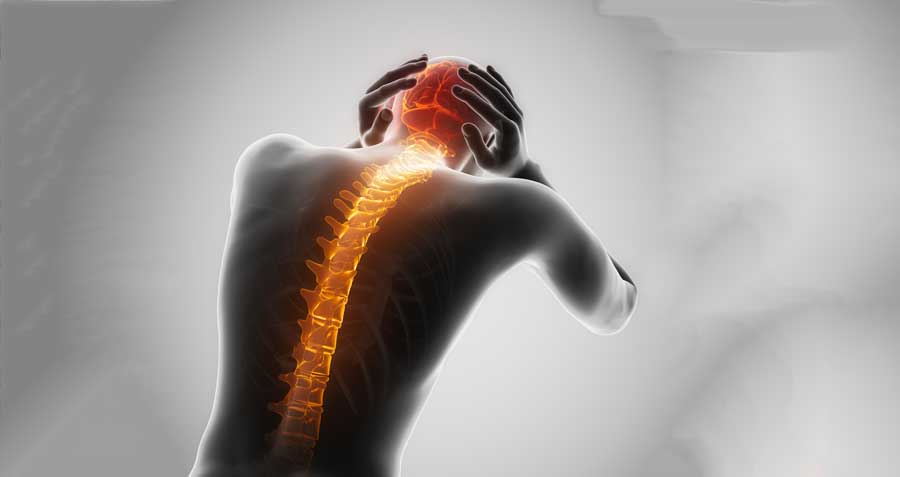
If you have undergone a spinal tap or epidural block procedure, your doctor may have warned you that you may be at risk of a spinal headache. Because these procedures sometimes involve a puncture of the dura mater, the tough outer membrane that encases the spinal cord, spinal fluid may leak out. With the loss of a significant amount of spinal fluid, you may experience headaches that can range in intensity from mild to incapacitating.
The good news is that the needle design has improved considerably in recent years, making it less likely that a puncture of the dura mater will occur. Still, about 30 percent of patients following a spinal tap will experience spinal headaches. However, almost 85 percent of patients who experience spinal headaches will have resolution of symptoms within six weeks.
What Causes Spinal Headaches?
The main initial cause of spinal headaches is any loss of structural integrity in the dura mater. Whether this is from a surgical procedure like a spinal tap or from an injury, the resulting leakage of cerebrospinal fluid (CSF) decreases the fluid pressure on the brain and spinal cord. In a healthy person, the brain floats in a sac of this fluid. However, with the loss of this cerebrospinal fluid the brain will lose structural support and deform slightly. This deformation is believed to strain tissues in the head that may produce pain. Another theory is that when blood vessels dilate in the brain, intense headache symptoms are triggered.
Although the most common causes of spinal headaches are procedures involving the spine, some people are at greater risk for these complications. People with Marfan syndrome, Ehlers-Danlos syndrome or polycystic kidney disease have weaker connective tissue and are more susceptible to tears in the meninges surrounding the brain and spinal cord. In some cases, these people may experience spinal headaches after a minor movement involving a sneeze or abrupt vehicle stop.
- Using a needle larger than 24-25 gauge in a procedure
- Positioning needle perpendicular to the spinal cord rather than at acute angle
- Female gender
- Pregnant
- Younger age between 30 and 50
- Any history of chronic headache prior to the surgery
Symptoms of Spinal Headaches
There are many symptoms that spinal headaches have in common with other chronic headache conditions, but one of the hallmarks of this particular headache is postural symptoms. People with spinal headaches tend to experience more intense symptoms within 15 to 30 minutes of sitting or standing up. This is due to the brain settling on the skull base. People often experience symptom relief upon lying down once again.
In addition to intensifying pain upon assuming an upright position, other spinal headache symptoms include:
- Dull or throbbing head pain
- Pain similar to a migraine
- Nausea
- Vomiting
- Difficulty thinking
- Double vision
- Tinnitus
- Vertigo
- Cortical blindness
In general, spinal headache symptoms usually resolve within six weeks as the tear heals and CSF levels return to normal. The longest case of spinal headaches recorded was 19 months.
In some rare cases, spinal headaches may lead to more serious health conditions like a subdural hematoma (internal bleeding on the skull that puts pressure on the brain).
Treating Spinal Headaches
Spinal headaches may be painful, even disruptive while they occur, but they are typically not a serious health concern. That is why most physicians will recommend conservative treatment options rather than more risky therapies. There is still ongoing debate as to the efficacy of some of the following therapies, but these are the most common treatments for spinal headaches recommended by clinicians.
More Conservative Treatments
- Bed rest—because spinal headaches often resolve on their own, unlike many other types of chronic headache, your physician may recommend that you merely rest for a few days to see if symptoms subside. Your doctor may also advise you to remain prone to limit stress on your brain until your cerebrospinal fluid has had a chance to replenish. (You should also note that there is at least one study that finds bed rest is not therapeutic for spinal headaches. This study found that bed rest, regardless of how the head is positioned, may actually worsen headache symptoms).
- Hydration—most medical experts recommend that you drink plenty of fluids following your surgery to assist your body in the production of CSF. You should listen closely to your doctor’s instructions, as it is possible to over-hydrate.
- Analgesics—for many patients, the headache symptoms are mild enough that they can be treated with over-the-counter medications like aspirin, acetaminophen (Tylenol) or ibuprofen (Motrin). You should discuss all drugs you take with your physician as health complications can arise even when using OTC drugs.
- Caffeine—although it is not well understood why, caffeine may offer some pain relief for spinal headaches. This caffeine may be administered in the form of tablets, but commonly available forms like coffee or soda may be just as effective.
Less Conservative Treatments
- Epidural blood patch—this is a more aggressive form of spinal headache treatment that involves injection of the patient’s own blood into the spinal canal. The insertion of additional fluid into the spinal canal slows or stops loss of cerebrospinal fluid from the spinal nerve; the blood should also clot over the opening, allowing it to heal. It also corrects some of the negative pressure from prior fluid loss, lowering the risk for spinal headaches.
- Epidural non–blood injections—some researchers have attempted using saline or dextran 40 instead of a patient’s blood. Although these substitutes are not consistently effective, there have been enough positive outcomes to suggest they are effective at relieving CSF loss and healing tears.
- Surgical intervention—if all others prove unsuccessful, then your physician may opt for a surgical remedy. The surgeon will manually close the opening in the dura mater, preventing any further loss of CSF.
Article written by: Dr. Robert Moghim – CEO/Founder Colorado Pain Care
M.D. Disclaimer: The views expressed in this article are the personal views of Robert Moghim, M.D. and do not necessarily represent and are not intended to represent the views of the company or its employees. The information contained in this article does not constitute medical advice, nor does reading or accessing this information create a patient-provider relationship. Comments that you post will be shared with all visitors to this page. The comment feature is not governed by HIPAA and you should not post any of your private health information.



